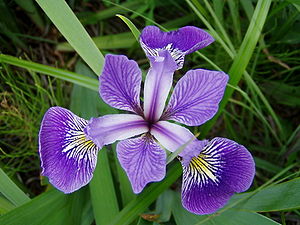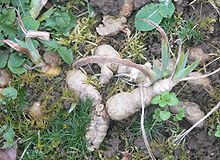Iris
| Iris | |
|---|---|
 | |
| Genus: | Iris |
| Family: | Iridaceae |
| Type: | Perennials |
| Pest issues: | Some serious |
| Pollination: | Insects |
Iris is a genus of between 200-300 species of flowering plants with showy flowers which takes its name from the Greek word for a rainbow, referring to the wide variety of flower colours found among the many species. As well as being the scientific name, iris is also very widely used as a common name and refers to all Iris species as well as some closely related genera.
The genus is widely distributed throughout the north temperate zone. Their habitats are considerably varied, ranging from cold regions into the grassy slopes, meadowlands, stream banks and deserts of Europe, the Middle East and northern Africa, Asia and across North America.
Description
[edit | edit source]They are perennial herbs, growing from creeping rhizomes (rhizomatous irises), or, in drier climates, from bulbs (bulbous irises). They have long, erect, flowering stems, which may be simple or branched, solid or hollow, and flattened or have a circular cross-section. The rhizomatous species usually have 3-10 basal, sword-shaped leaves growing in dense clumps. The bulbous species have cylindrical basal leaves.

The leaves are simple, narrow, 2-ranked, and flat with parallel veins. The leaves are actually folded over and fused, so that only the underside of the leaf is exposed. Sword shaped or linear.
The inflorescences are borne on stiff, pithy scapes, are fan-shaped and contain one or more symmetrical, six-lobed, slightly fragrant flowers. These grow on a pedicel or lack a footstalk. The three sepals are spreading or droop downwards. They expand from their narrow base into a broader limb (= expanded portion), often adorned with lines or dots. The three, sometimes reduced, petals stand upright, partly behind the sepal bases. Some smaller iris species have all six lobes pointing straight outwards. The sepals and the petals differ from each other. They are united at their base into a floral tube, that lies above the ovary. The styles divide towards the apex into petaloid branches (see pollination, below).
Irises come with their own lingo that describes the various forms of the flowers, falling into one of three categories. They appear to have 9 tepals, but in fact have only 6 (the other three are the style arms). The upright tepals are called standards, while the pendant ones are called falls.
The iris flower is of special interest as an example of the relation between flowering plants and pollinating insects. The shape of the flower and the position of the pollen-receiving and stigmatic surfaces on the outer petals form a landing-stage for a flying insect, which in probing the perianth for nectar, will first come in contact of perianth, three with the stigmatic stamens in one whorl surface which is borne and an ovary formed of three carpels. The shelf-like transverse projection on the inner whorl under side of the stamens, which is beneath the over-arching style arm below the stigma, so that the insect comes in contact with its pollen-covered surface only after passing the stigma, while in backing out of the flower it will come in contact only with the non-receptive lower face of the stigma. Thus, an insect bearing pollen from one flower, will in entering a second, deposit the pollen on the stigma, while in backing out of a flower, the pollen which it bears will not be rubbed off on the stigma of the same flower.
The fruits are 3-celled capsules, 3 or 6 angled, opening on 3 valves, leathery, smooth, ribed[check spelling], or bumpy, persisting often past the winter.
Species
[edit | edit source]Up to 300 species have been placed in the genus Iris. Modern classifications, starting with W. R. Dykes' 1913 book, have subdivided them. Dykes referred to the major subgroupings as sections, but later authors have generally called them subgenera, while essentially retaining his groupings. Like some older sources, the influential classification by G. I. Rodionenko removed some groups (particularly the bulbous irises) to separate genera, but even if this is done the genus remains large and several subgenera, sections and/or subsections are recognised within it.
For horticultural purposes, the Irises are divided into the bulbous and rhizomatous species, and the Iris flowers fall into one of three classifications:
“Bearded Iris” has a pattern of hairs (the beard) in a differently colored patch is showy on the basal half or the falls.
“Unbearded Iris” has a differently colored patch (the signal) is showy on the basal half of the falls.
“Crested Iris” has a differently colored patch with a prominently raised hairy midrib (the crest) which is showy on the falls.
Uses
[edit | edit source]Primarily grown for their flowers, though some are also grown for their clean, upright foliage. Often grown for cut flowers as well.
Rhizomes of the bearded iris are the source of orris root and are used in perfume and medicine, though more common in ancient times than today. Today Iris essential oil (absolute) from flowers are sometimes used in Aromatherapy as sedative medicines. The dried rhizomes are also given whole to babies to help in teething.
For making perfumes, the rhizomes are harvested, dried, and aged for up to 5 years. In this time, the fats and oils inside the roots undergo degradation and oxidation, which produces many fragrant compounds that are invaluable in perfumery. The scent is said to be similar to violets. The aged rhizomes are steamed distilled which produces a thick oily compound, known in the perfume industry as iris butter.
Maintenance
[edit | edit source]
Rhizomatous irises need to be divided every few years, as the centers die out after a time, leaving only a "ring" of foliage and flowers around the edge of the dead center. Planting depth is important, as the rhizomes do not tolerate being buried.
Voles can cause serious damage, particularly during the winter, so monitor carefully during the winter months.
Iris foliage emerges very early, so the previous year's foliage should be cut back before thaw when possible.
Propagation
[edit | edit source]Division is the most common form of propagation.
Pests and diseases
[edit | edit source]Pests
[edit | edit source]- Melon Aphid: Aphis gossypii
- True Bulb Aphid: Dysaphis tulipae
- Potato Aphid: Macrosiphum euphorbiae
- Crescent-marked Lily Aphid: Neomyzus circumflexus
- Peach Aphid: Myzus persicae
- Florida Red Scale: Chrysomphalus aonidum
- Iris Whitefly: Aleyrodes spiraeoides
- Ground Mealybug: Rhizocecus falcifer
- Plant Bug: Lopidea confluenta
- Tobacco Thrips: Frankliniella fusca
- Iris Thrips: Iridothrips iridis
- Gladiolus Thrips: Thrips simplex
- Onion Thrips: Thrips tabaci
- Rose Thrips: Thrips major
- Lesser Bulb Fly: Enumerus tuberculatus
- Narcissus Bulb Fly: Merodon equestris
- Japanese Beetle: Popillia japonica
- Iris Weevil: Monomychus vulpeculus
- Zebra Caterpillar: Ceramica picta
- Verbena Bud Moth: Endothenia hebesana
- Iris Borer: Macronoctua onusta
- Stalk Borer: Papaipema nebris
- Bulb Mite: Rhizoglyphus echinopus
Diseases
[edit | edit source]Bacterial Leaf Spots
- Xanthomonas tardicrescens
- Alternaria iridicola
- Ascochyta iridis
- Didymellina macrospora
- Mycosphaerella
- Phyllosticta iridis
- Botrytis cinerarea
- Glomerella cingulata
- Botryotinia convoluta
- Fusarium oxysporum f. sp. gladioli
- Pellicularia rolfsii
- Sclerotinia sclerotiorum
- Mystrosporium adustum
- Penicillium
- Puccinia iridis
- Puccinia sessilis
- Iris Mosaic Virus
Other Problems
[edit | edit source]Hollow centers -- Rhizomatous Irises dies out in the center if not divided every few years.
References
[edit | edit source]- Kew Checklist: Iris
- Dykes, W. R. (1913). The genus Iris. Cambridge: Cambridge University Press.
- Rodionenko, G. I. (1961). The genus Iris L.. Moscow and Leningrad.
- Species Group of the British Iris Society (1996) - A Guide to Species Irises: Their Identification and Cultivation; Cambridge University Press; ISBN 0-521-44074-2 (a comprehensive, up-to-date survey of Iris)
- Flora of North America: Iris
- A web site devoted to Irises, by David Payne-Joyce; includes plates from Dykes (1913).
- The American Iris Society
- Iris taxonomy in GBIF Biodiversity Data Portal
- Historic Iris Preservation Society
- Ann Fowler Rhoads and Timothy A. Block (2000). The Plants of Pennsylvania: An Illustrated Manual. Anna Anisko, illustrator. Morris Arboretum, University of Pennsylvania Press. pp. 840–842.
{{cite book}}: Cite has empty unknown parameter:|coauthors=(help) - Christopher Brickell and Judith D. Zuk (1997). The American Horticultural Society A-Z Encyclopedia of Garden Plants. DK Publishing. pp. 556–565.
{{cite book}}: Cite has empty unknown parameter:|coauthors=(help) - Staff of the L. H. Bailey Hortorium (1976). Hortus Third: A Concise Dictionary of Plants Cultivated in the United States and Canada. Cornell University Press. pp. 598–606.
{{cite book}}: Cite has empty unknown parameter:|coauthors=(help) - Pirone, Pascal P. (1978). Diseases & Pests of Ornamental Plants (Fifth Edition ed.). John Wiley & Sons, New York. pp. 316–321.
{{cite book}}:|edition=has extra text (help); Cite has empty unknown parameter:|coauthors=(help) - Cranshaw, Whitney (2004). Garden Insects of North America: The Ultimate Guide to Backyard Bugs. Princeton University Press. p. 601.
{{cite book}}: Cite has empty unknown parameter:|coauthors=(help) - Pippa Greenwood, Andrew Halstead, A.R. Chase, Daniel Gilrein (2000). American Horticultural Society Pests & Diseases: The Complete Guide to Preventing, Identifying, and Treating Plant Problems (First Edition ed.). Dorling Kindersley (DK) Publishing, inc. p. 200.
{{cite book}}:|edition=has extra text (help); Cite has empty unknown parameter:|coauthors=(help)CS1 maint: multiple names: authors list (link)
